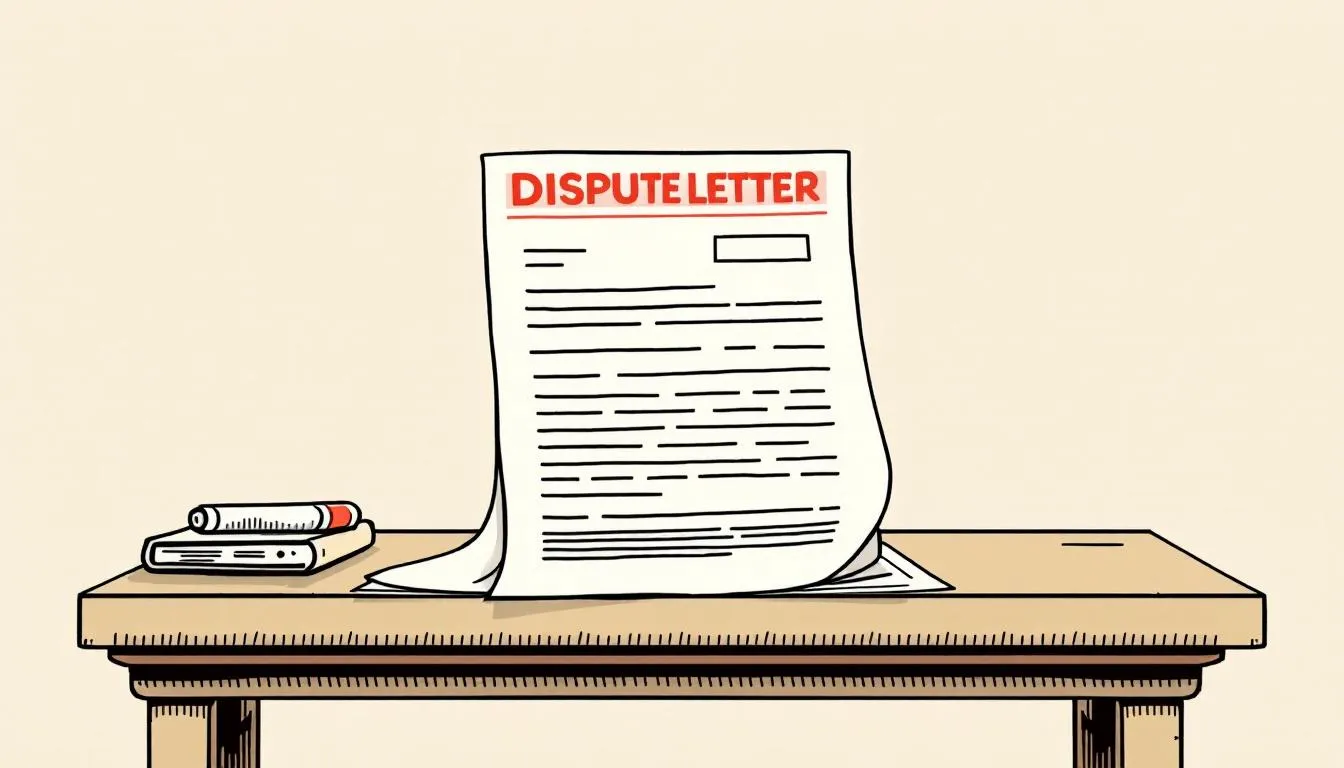If you’ve found errors on your credit report, writing a credit letter of dispute is essential to correct them. In this guide, we’ll explain why these letters matter, how to draft them, and what steps to take to ensure your credit report reflects your true financial history.
Key Takeaways
A credit letter of dispute is essential for addressing inaccuracies in credit reports to protect and improve credit scores.
An effective dispute letter should clearly outline inaccurate information, include supporting documents, and be sent via certified mail to ensure delivery.
If a dispute is rejected, consumers can take further action, such as re-submitting the dispute with additional documentation or filing complaints with the Consumer Financial Protection Bureau.
Understanding Credit Letter of Dispute

A credit letter of dispute is a formal request sent to credit bureaus to rectify inaccuracies on a credit report. These inaccuracies could range from incorrect personal information to erroneous account details that negatively impact your credit scores. The primary goal of a dispute letter is to compel the reporting agency or creditor to investigate and amend any false claims in your credit history.
Sending a dispute letter prompts credit bureaus to verify the accuracy of their reported information. Unverifiable information must be corrected or removed from your credit report. This step is important because inaccuracies can significantly lower your credit scores, impacting your ability to secure loans, credit cards, or employment opportunities.
Addressing errors in your credit report is not just about improving your credit score; it can also enhance your chances of securing housing or employment. A well-crafted dispute letter should clearly state the inaccuracies and request the necessary corrections. This ensures that your credit report accurately reflects your financial behavior, thereby enhancing your overall financial health.
Reasons to Write a Credit Letter of Dispute

Disputing inaccuracies in your credit report is crucial for maintaining a favorable credit score. Errors can lead to higher interest rates on loans, increasing your long-term costs. For example, an incorrect late payment can lower your score, resulting in higher mortgage rates or even credit denial.
Moreover, writing a dispute letter can help rectify errors that may prevent you from obtaining loans or credit. Imagine being denied a car loan because of an incorrect delinquency reported on your credit report.
Disputing these inaccuracies ensures that your credit report is inaccurate and accurately reflects your financial behavior, improving your chances of securing loans and credit at favorable terms.
How to Draft an Effective Credit Letter of Dispute
Drafting an effective credit letter of dispute requires clarity and detail. Your letter should include:
A clear outline of each disputed item along with factual explanations to facilitate the review process.
Specific details about the disputed information to help expedite the correction process.
Supporting documents such as payment records or court decisions to significantly enhance the effectiveness of your dispute.
A well-structured dispute letter enhances your chances of a successful resolution. The following section outlines the key elements to include and provides a sample letter to guide you.
Key Elements to Include
Certain key elements are essential for drafting a successful credit dispute letter. Begin with your contact details — name, address, and phone number — followed by the date, ensuring the credit bureau knows exactly who is submitting the dispute and how to contact you.
Next, identify the account number in question and provide a specific description of the disputed information. Clearly state each disputed item by referencing the source and detailing the nature of the error. For example, if an account is incorrectly marked as delinquent, specify the account number, the incorrect status, and the correct information. Also, include a clear request to describe the investigation and correction, maintaining a professional tone throughout.
Finally, enclose copies of any supporting documents that can substantiate your claims. This could include payment records, court decisions, or any other relevant documents. List all enclosures at the end of your letter and keep the originals for your records. A clear, detailed dispute letter with supporting documents can significantly improve your chances of a successful resolution.
Sample Credit Dispute Letter
Here is a sample credit dispute letter template to help you get started:
[Your Name]
[Your Address]
[City, State, Zip]
[Date]
[Credit Bureau Name]
[Bureau Address]
Dear [Credit Bureau Name],
I am writing to dispute the following information in my credit report: [Specific Account Details and Disputed Information]. This information is incorrect because [Reason for Dispute]. I am requesting that the following items be investigated and corrected: [List of Disputed Items].
Enclosed are copies of [Supporting Documents] to assist with the investigation, enclosing the correct information supplied for removal to reinvestigate at the earliest.
Sincerely,
[Your Name]Customize this template to address specific inaccuracies on your credit report by:
Ensuring clarity in your explanation.
Providing necessary documentation to support your claims.
Following up after sending the letter to ensure your dispute is processed and resolved.
Sending Your Credit Letter of Dispute
Once your dispute letter is ready, the next step is to send it to the credit bureaus. The recommended method is:
Send your dispute letter via certified mail with return receipt requested.
This ensures you have proof that the credit bureau received your letter, which can be crucial if there are any issues later on.
While filing disputes online is an option, it may lead to waiving certain rights.
Therefore, certified mail is a safer choice.
Additionally, you should:
Notify both the credit reporting agency and the entity that provided the incorrect information. This dual notification increases the likelihood of a thorough investigation and resolution.
Include copies of supporting documents.
Include a circled copy of your credit report with the disputed items clearly marked.
If your dispute letter includes enclosed documents, list all enclosures at the end of your letter. This makes it easy for the credit bureau to verify your claims and can expedite the resolution process. A well-documented dispute letter sent via certified mail can significantly enhance your chances of correcting inaccuracies on your credit report.
Following Up on Your Dispute

After sending your dispute letter, follow these steps:
Follow up to ensure that the credit bureau makes the necessary corrections.
Regularly monitor your credit report to confirm that the agreed corrections have been implemented.
If the credit bureau deems your dispute ‘frivolous,’ they must notify you and provide reasons for halting the investigation.
If your dispute is dismissed, you can request to add a statement to your credit report explaining your disagreement. This consumer statement allows you to present your side of the story to potential creditors, ensuring that they understand the context of the disputed item. Keeping track of any changes in your credit report is crucial for managing disputes effectively.
Stay proactive and continue to monitor your credit report, especially after filing disputes. This vigilance ensures that your credit report remains accurate and that any errors are corrected promptly.
What to Do If Your Dispute Is Rejected
If your dispute is rejected, don’t lose hope. Here are your next steps:
The credit bureau has a 30-day window to complete their investigation and inform you of the results in writing.
If the bureau fails to address your dispute adequately, you have the right to pursue legal action.
Assistance from a lawyer can provide additional options and resources for navigating unresolved disputes.
You can take the following actions if you believe your rights under the Fair Credit Reporting Act have been violated:
Lodge a complaint with your state attorney general.
Reach out directly to the lender for further clarification and assistance, which can sometimes resolve the issue.
Resubmit your dispute with new supporting documents to strengthen your case for reconsideration.
Filing a complaint with the Consumer Financial Protection Bureau can provide additional support for unresolved disputes. These steps ensure that your rights are protected and that any inaccuracies in your credit report are addressed.
Using Dispute Beast for Automated Disputes
For those looking to simplify the dispute process, Dispute Beast offers an automated AI credit disputing solution designed to improve your credit scores. Dispute Beast streamlines the dispute process by automating the generation of personalized letters aimed at major credit bureaus and secondary bureaus like LexisNexis and Innovis. This tool is free when users maintain an active and paid subscription to specific credit monitoring services.
Dispute Beast simplifies the credit dispute process by guiding users on every step, including what documents to send with dispute letters for the best results:
Automating the generation of dispute letters
Offering both manual and automated mailing options, allowing users to choose their preferred method for handling disputes
Providing a user-friendly platform that enables quick action in just five minutes
How Dispute Beast Works
Using Dispute Beast is straightforward. Users load their credit reports into the platform, enabling them to send dispute letters with just one button press. There are two mailing options after creating an attack: Sprint Mail (Paid) and Free Download (DIY). The quicker the letters go out, the sooner credit bureaus must respond.
Dispute Beast uses a three-level strategy to challenge credit reporting agencies, creditors, and secondary credit bureaus, ensuring comprehensive dispute coverage. The user process involves:
Loading their credit report
Pressing one button
Printing and mailing the letters
Repeating the process every 40 days
Most users see results after 6–12 attack rounds while maintaining good financial habits such as on-time payments, low utilization, and limited inquiries related to money.
With Beast Credit Monitoring and Pro Credit Watch, users can track their progress using the same credit scoring models that lenders use: FICO 8 and Vantage 3.0. This comprehensive approach ensures effective and efficient management of credit health.
Benefits of Dispute Beast
Dispute Beast offers numerous benefits, including ease of use, continuous monitoring, and compliance with legal standards. The platform processes letters to dispute erroneous items on consumers’ accounts, ensuring maximum results while adhering to legal timelines such as the Fair Credit Reporting Act (FCRA) and the Fair Debt Collection Practices Act (FDCPA).
Dispute Beast crafts letters using consumer protection laws, Metro 2 compliance, and case law references that are reviewed. It also uses different fonts and formats to make each letter unique, increasing the chances of a successful dispute resolution and demonstrating a commitment to care. Each file is tailored to meet specific needs that matter.
Dispute Beast allows users to take control of their credit repair process with confidence and ease.
Summary
Maintaining an accurate credit report is vital for your financial health. From writing a credit letter of dispute to using automated solutions like Dispute Beast, there are various ways to ensure that your credit report accurately reflects your financial behavior. Addressing errors in your credit report can significantly improve your credit scores and enhance your chances of securing loans and favorable interest rates.
By following the best practices outlined in this blog post, you can take control of your credit health. Whether you choose to draft a dispute letter yourself or use an automated tool like Dispute Beast, the key is to be proactive and vigilant. Take charge of your credit report today and pave the way for a more secure financial future.
Frequently Asked Questions
What is the main purpose of a credit letter of dispute?
The primary purpose of a credit letter of dispute is to address inaccuracies on your credit report, urging the credit bureau to investigate and correct any erroneous information. By doing so, you can help ensure your credit history accurately reflects your financial behavior.
Why is it important to dispute errors on your credit report?
It is essential to dispute errors on your credit report, as inaccuracies can adversely affect your credit scores, resulting in higher interest rates and potential denial of loan applications. Taking action to correct these errors ensures your creditworthiness is accurately reflected.
How should I send my credit dispute letter to ensure it is received?
To ensure your credit dispute letter is received, send it via certified mail with return receipt requested. This method provides confirmation of receipt by the credit bureau.
What should I do if my dispute is rejected?
If your dispute is rejected, you should consider seeking legal assistance, resubmit your dispute with additional supporting documents, or file a complaint with the Consumer Financial Protection Bureau for further resolution.
How does Dispute Beast simplify the dispute process?
Dispute Beast simplifies the dispute process by automating personalized dispute letter generation and offering both manual and automated mailing options. This streamlining of tasks helps users efficiently manage their disputes.



